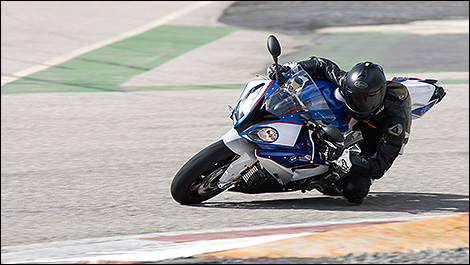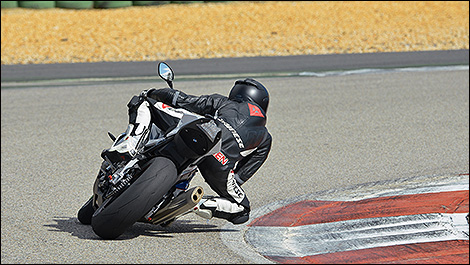Seville, Spain -- The ultra-powerful and racy-looking BMW S1000RR, which hit the market in 2009, has always been an exclusive bike for extreme riders. Close to a race bike, this exhilarating and delinquent German rocket demands plenty of effort and concentration.
The S1000RR's project chief, Rudolf Schneider, gathered his team and revised all the components to not only improve performance, but also make it more accessible to less experienced riders. Not a single square inch was left to guesswork, and the 2015 BMW S1000RR is now a quick and fast superbike in the hands of anyone.
I got the privilege to attend the global launch on the fabulous Monteblanco race track in Seville.
Upgrades to the 2015 BMW S1000RR
- Sleeker styling;
- Lighter, stiffer frame;
- Revised geometry (for more agility in corners and more stability under acceleration);
- Improved Dynamic Damping Control (DDC) -- optional;
- Lighter battery;
- Increased power and torque, with a more linear delivery;
- Ride-by-wire throttle;
- Revised exhaust system;
- New, fully programmable User mode;
- 15-level Dynamic Traction Control (DTC);
- Upgraded wheelie control;
- New location for gyroscopic sensor;
- Improved Race ABS adapts to weight transfers and disables rear-wheel ABS in both Slick and User modes;
- Riders can shift from Slick to User on the fly to compare adjustments;
- Launch control and pit-lane limiter;
- Shifter HP Pro allowing clutch-less shifts;
- Gear selector is easy to flip for standard or GP-style fitment;
- New sensor box;
- Advanced data acquisition system -- optional;
- New instrument panel displaying intake air temperature, deceleration, lean angle, and DTC-induced torque reduction;
- Cruise control and heated grips.
GP-class equipment
Upon straddling the 2015 BMW S1000RR, I noticed that the riding position is the same as the outgoing model's, with plenty of room and the ability to lean your upper body well over the front wheel for superior grip when entering corners.
The first startling bit of equipment was Shifter HP Pro, which allows you to upshift and downshift without using the clutch and even does seamless rev-matching for you. The clutch lever is only needed when you start the bike and return to the paddocks.
The new instrument panel features a super easy-to-read tachometer and a complex digital display with probably more information than you can digest. That's why there's an advanced data acquisition system: Just plug in a USB drive to transfer everything to your laptop and make a thorough assessment of your progress on the track.
A winning combination
My second lapping session allowed me to validate the improvements made to the chassis. Monteblanco has slow corners and quick S-turns, and the 2015 BMW S1000RR showed me how much more agile it's become. With the Shifter HP Pro, slipper clutch, Race ABS, DDC, and revised geometry all working in sync, you can brake hard and late and literally sink the front tire into the tarmac as you attack a corner.
In super-tight corners, the S1000RR wants you to lean as close to the ground as possible in order to maintain a higher speed. You get an excellent feel for front-wheel grip thanks to the revised frame and DDC suspension. When exiting those same corners, the machine also gets back to an upright stance more easily.
 |
| Upon straddling the 2015 BMW S1000RR, I noticed that the riding position is the same as the outgoing model's. (Photo: Joerg Kuenstle) |
Manageable power
When I rode the BMW HP4 on various tracks across Canada, I had to deal with a twitchy engine that delivered power in stages, thus compromising rear-wheel grip and traction control. While the new S1000RR is more powerful than ever, it also proves easier to exploit. From 5,000 rpm, the inline 4-cylinder engine unleashes more torque without binding the steering like the HP4 did.
Despite a more progressive nature, the S1000RR can still prance like a wild stallion. The upgraded wheelie control system simply takes a bit of violence out of the manoeuvre.
As I accelerated out of the numerous corners in second gear, traction control stepped in fairly quickly in Slick mode with a +7 DTC setting (the most intrusive, equivalent to Rain mode). It's perfect for a beginner or anyone getting familiar with a new track. With DTC set at +2, and then at 0, the system becomes less intrusive, so intermediate riders can confidently improve their lap times.
The S1000RR works with you
My last two sessions on the track with the 2015 BMW S1000RR (equipped with Pirelli slick tires) allowed me to assess the performance of the bike with the least intrusive DTC settings (-3 to -7). While the system did overstay its welcome at times, like when I hit a bump at a lightning-quick pace, it proved a lot more transparent most of the time. At -6 or -7 DTC will only intervene if you make a mistake. It no longer works
for you but rather
with you, ensuring sharper corner exits.
When all was said and done, I knew this for a fact: The HP4 world just opened up to a larger number of enthusiasts. More powerful and more agile, yet easier to exploit and safer than ever, the new 2015 BMW S1000RR is as close to perfect as a superbike can be.
 |
| Despite a more progressive nature, the S1000RR can still prance like a wild stallion. (Photo: Alberto Martinez) |
Pros
- Easier to exploit
- Sharper, more finely tuned electronic aids
- Shifter HP Pro and DDC work great
- The industry's most precise ride-by-wire throttle
- User mode is a blessing
Cons
- DTC intervention is too long at times
- Suspension is still a bit too firm on rough pavement

